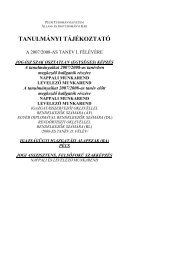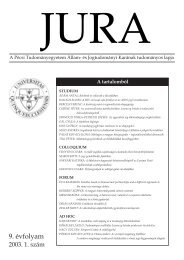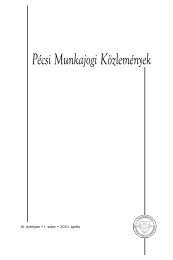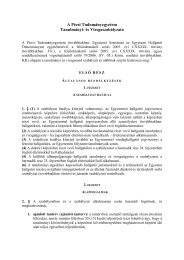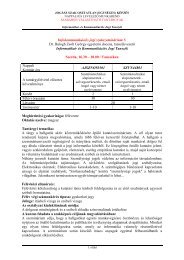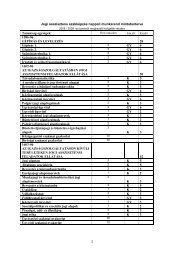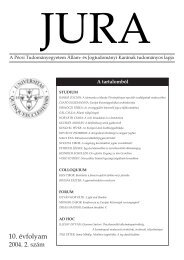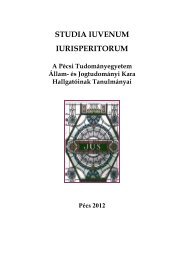184 André Ramos Tavares: The case of the borderless use of Constitutional Courts decisions in human rightsproclaimed in formal constitutions that should notbe transformed into semantic constitutions, to useLoewenstein’s terminology.BibliographyAlford, Roger P.. Roper v. Simmons and our constitutionin international equipoise. In: University of California lawReview, 2005, v. 1.Bastos, Celso Ribeiro, Tavares, André Ramos. As tendênciasdo direito público: no limiar de um novo milênio. São Paulo:Saraiva 2000Buys, Cindy G.. Burying our constitution in the sand?Evaluating the osthrich response to the use of international andforeign law in U.S. Constitutional interpretation. In: BrighamYoung University J. Pub. Law, n. 21. 2007Canotilho, J. J. Gomes. Direito Constitucional. 4. ed.Coimbra: AlmedinaCappelletti, Mauro. Il Controllo giudiziario di costituzionalitàdelle leggi nel diritto comparato. reimpr. Milano: Giuffrè,1970. (Studi di Diritto Comparato).Juízes legisladores?. Tradução: Carlos Alberto Alvaro deOliveira. Porto Alegre: Sérgio Antonio Fabris Editor, 1993Carpentier, Elise. La utilización de la jurisprudencia constitucionalextranjera por el conselho constitucional francés. In:Memoria del X Congreso Iberoamericano de Derecho Constitucional.Lima, 16-19 de setiembre de 2009. Bibliografia: p. 623-36.Chang, Nancy. Silencing political dissent. New York: SevenStories Press, 2002Cole, David, Dempsey, James X. Terrorism and the constitution.Sacrificing civil liberties in the name of national security.New York: The New York Press, 2002García Belaunde, Domingo. De la jurisdicción constitucionalal derecho procesal constitucional. Querétaro: FUNDAp, 2004Gillispie, Charles Coulton (org.). Dicionário de biografiascientíficas. v. 1. Trad. por Carlos Almeida pereira. Rio de Janeiro:Contraponto, 2007. Bibliografia: 525-31.Gutmann, Amy, Thompson, Dennis. Democracy andDisagreement: why moral conflict cannot be avoided in politics,and what should be done about it. Cambridge/London: TheBelknap Press of Harvard Univ. Press., 1996Why Deliberative Democracy? Princeton: Princeton Univ.Press, 2004Häberle, Peter. Derecho constitucional común europeo.In: Perez Luño, Antonio-Enrique (coord.). Derechos humanosy constitucionalismo ante el tercer milenio. Madrid: MarcialPons: 1996Harding, Sarah K.. Comparative Reasoning and JudicialReview. In: Yale Journal of International Law, v. 28, 2003Hespanha, António Manuel. Categorias. Uma reflexãosobre a prática de classificar. In: Análise Social, vol. XXXVIII(168), 2003. Bibliografia: 823-840.Ideias sobre a intepretação. México, 2008Hentoff, Nat. The war on the bill of rights and the gatheringresistance. New York: Seven Stories Seven. 2004Kahn, Paul W.. Interpretation and authority in stateconstitutionalism. In: Harvard Law Review, v. 106, 1993Mirkine-Guetzevitch. Modernas tendencias del derechoconstitucional. Madrid: ed. Reus, 1934Müller, Friedrich. Métodos de trabalho do direito constitucional[tradução de Peter Naumann]. <strong>2.</strong> ed. São Paulo: MaxLimonad, 2000Tesis acerca de la estructura de las normas jurídicas [traduçãopara o espanhol por Luis Villacorta Mancebo]. Madrid: Centrode Estudios Constitucionales, 1989Neves, Marcelo. Transconstitucionalismo. São Paulo, 2009.(Thesis presented to the selection process for chief professorof Constitutional Law at the Faculty of Law at São PauloUniversity).Parrish, Austen L.. Storm in a teacup: the U.S. SupremeCourt’s use of foreign law. In: University of Illinois Law Review,2007Perry, Michel. The constitution in the courts: law or politics?New York: Oxford University Press, 1994Posner, Richard. Pragmatic adjudication. In: Cardozo LawReview, n. 18, 1996Rubio Llorente, Francisco. La integración supranacional.In: García de Enterría, Eduardo e Clavero Arevalo, Manuel(coords.). El derecho público de finales de siglo: una perspectivaiberoamericana. Madrid: Ed. Civitas/ Fundación BBV, 1997Scalia, Antonin. Originalismo: o mal menor. Traduçãopor Pedro Buck. Revista Brasileira de Estudos Constitucionais –RBEC. Belo Horizonte, ed. Fórum, ano 1, n. 3, p. 25-43, jul./set., 2007Sunstein, Cass R. A constitution of many minds: why thefounding document doesn’t mean what it meant before. NewJersey: Princeton University Press, 2009Tushnet, Mark. The possibilities of comparative constitutionallaw. In: The Yale Law Journal, v. 108, n. 6, abr. 1999.Bibliografia: 1225-1309.Referring to foreign law in constitutional interpretation:an episode in the culture wars. In: University of Baltimore LawReview, n. 35, 2006Tavares, André Ramos. Teoria da Justiça Constitucional.São Paulo: Saraiva, 2005Fronteiras da Hermenêutica Constitucional. São Paulo:Método, 2006Democracia deliberativa: elementos, aplicações e implicações.Revista Brasileira de Estudos Constitucionais – RBEC.Belo Horizonte, ed. Fórum, ano 1, n. 1, p. 79-103, jan./mar.,2007a.O discurso dos direitos fundamentais na legitimidade edeslegitimação de uma justiça constitucional substantiva. In:Revista Brasileira de Estudos Constitucionais. 2007b, n. <strong>2.</strong>O originalismo e a Justiça Constitucional substantiva.Revista Brasileira de Estudos Constitucionais – RBEC. BeloHorizonte, ed. Fórum, ano 1, n. 3, p. 15-24, jul./set., 2007c.Bibliografia: 15-24.Curso de Direito Constitucional. 7. ed. São Paulo: Saraiva,2009a.Nova Lei da Súmula Vinculante. Estudos e Comentários à Lei11.417, de 19.1<strong>2.</strong>2006. 3. ed. São Paulo: Método, 2009b.Zamudio, Héctor Fix. Veinticinco años de evolución de lajusticia constitucional. 1940-1965. [1. ed.]. México: UniversidadNacional Autónoma de México, 1968. (Publicaciones del XXVAniversario, n. 3-A).La protección jurídica y procesal de los derechos humanos antelas jurisdicciones nacionales [1. ed.]. Madrid: Civitas; México:Universidad Nacional Autónoma de México, 198<strong>2.</strong> (EstudiosComparativos, n. 21).Zehnder, Jacob. Constitutional comprarativism: theemerging risk of comparative law as a constitutional tiebreaker.In: Valparaiso University Law Review, n. 41, 2007Notes1The doctrine generally analyzes the theme withoutmaking a distinction in the treatment as to the use of foreignstate elements, international elements or supra-national ones(taking into consideration the necessary distinction betweenforeign Law and international Law: Buy s, 2007: 4); withinthese, a differentiation is also not usually made between theuse of foreign laws and the use of foreign judicial decisions, or,within these, as to the specific use of constitutional decisionsunder the terms described below.2„Capable of controlling the mastodon legislator and theleviathan administrator.” (Cappelletti, 1993: 18).3As, on many occasions, occurs in Brazilian constitutionalcase law.JURA 2012/<strong>2.</strong>
André Ramos Tavares: The case of the borderless use of Constitutional Courts decisions in human rights1854I will not enter into a discussion about the differentlevels of acceptance of the use of foreign case law based onthe distinction between civil law models and those of commonlaw, since that is not the focus of this proposal.5Understood, here, in the terms expressed below.6Supranationality is understood here according to theconcept of Francisco Rubio Llorente: “From the legal point ofview, the notion of supranationality entails the existence ofa structure composed of distinct States that keep title to theirsovereignty, but composed also of its own departments, thedecisions of which are imposed upon the member States; moreprecisely, it is a structure that has a direct effect on the territoryof the States and that, in the event of collision, the laws createdby such States prevail.” (Rubio Llorente, 1997: 719)7For precisely this reason, the expression “foreign caselaw” is preferred over “non-national case law”, thereby avoidingconfusion, since the latter can mean both the case law ofother states, excluding the „receiving” State (in this sense,non-national) and case law arising from supra-state or supranationalcourts (in this sense, non-national and, therefore,excluding case law formatted in traditional national terms).8Foreign elements alien to the spectrum mentionedpreviously will only be an indirect part of this work in theprecise measure in which they have been considered determiningfactors by the very foreign decision used by a nationalConstitutional Court. The non-direct use (via doctrine, forexample) of foreign constitutional case law also will not bethe object of concern.9In parallel with the previous footnote. This is evidentlya case of a note that allows for a reduction in the complexityof the theme, since it prevents domestic discussion necessarilylinked to a hierarchical model of judicial subordination or ofsubordination to the binding decisions of the ConstitutionalCourt in light of (and in spite of) free judicial conviction andthe (controversial) non-binding nature of the grounds for theconstitutional decisions.10Buys develops a line of reasoning that ends up admittingthat the use of foreign constitutional case law by theUnited States is also necessary (Buys, 2007: 48).11Parrish (2007: 662) notes the irony present here, for theAmerican case, especially considering that the United States i)insist on imposing their laws [and values] upon the rest of theworld; ii) routinely ignore the sovereignty of other nations.12Considered one of the most progressive constitutionsin the world.13In this sense: Bu y s, 2007: 50 e ss., although allowingforeign elements only when the the language of the Constitutionitself does not offer an answer to the question.14Already seen in post 9/11 legislation and decisions.JURA 2012/<strong>2.</strong>



